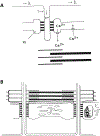Clinical and biochemical footprints of inherited metabolic disorders: X. Metabolic myopathies
- PMID: 36155185
- PMCID: PMC10507680
- DOI: 10.1016/j.ymgme.2022.09.004
Clinical and biochemical footprints of inherited metabolic disorders: X. Metabolic myopathies
Abstract
Metabolic myopathies are characterized by the deficiency or dysfunction of essential metabolites or fuels to generate energy for muscle contraction; they most commonly manifest with neuromuscular symptoms due to impaired muscle development or functioning. We have summarized associations of signs and symptoms in 358 inherited metabolic diseases presenting with myopathies. This represents the tenth of a series of articles attempting to create and maintain a comprehensive list of clinical and metabolic differential diagnoses according to system involvement.
Keywords: Exercise intolerance; Hypotonia; Rhabdomyolysis; Skeletal muscle; Weakness.
Copyright © 2022 Elsevier Inc. All rights reserved.
Conflict of interest statement
Declaration of Competing Interest The authors have no conflicts of interest to declare.
Figures



References
Publication types
MeSH terms
Grants and funding
LinkOut - more resources
Full Text Sources
Medical

